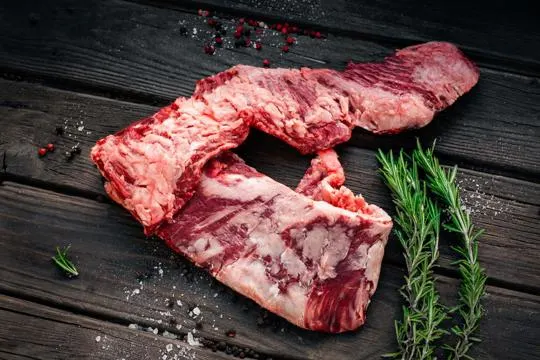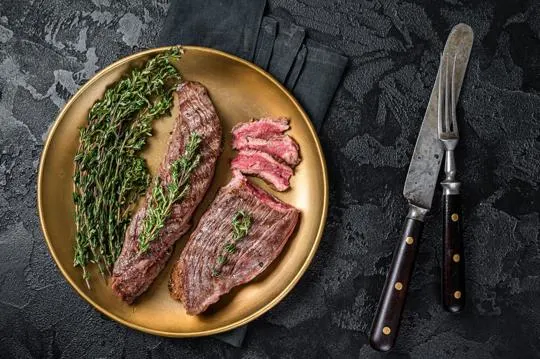Summary of key points
The primary difference between bavette steak and flank steak lies in their cut location on the cow and texture. Bavette steak, also known as flap steak, is cut from the bottom sirloin, near the cow’s belly, and is known for its strong beef flavor and tenderness when cooked properly. Flank steak, sourced from the cow’s abdominal muscles, has a grainier texture and is also flavorful but tends to be a bit tougher, requiring careful preparation and slicing against the grain to maximize tenderness.
Ever stood in front of the meat section, scratching your head, trying to figure out the difference between bavette steak and flank steak? It’s like trying to pick a favorite child.
Sometimes, we feel like culinary detectives. Last Tuesday, for instance, I was on a mission to impress with my steak game. Googled recipes. Ended up more confused.
One thing’s clear. These two cuts of beef often get mixed up. Both come from the abdominal muscles of the cow. Yet, they’re not twins. Not even siblings.
Cousins, maybe?
Bavette steak is all about that loose texture and intense beefy flavor. Flank steak? It’s lean, mean, and loves the grill.
In our kitchen, it’s a friendly battle. Bavette vs. Flank. Which side will you pick?
Stick around. We’re about to slice into the juicy details.
What is Bavette Steak?

Bavette steak, also known as flap steak, is a tasty and tender cut of beef. It’s from the bottom sirloin.
The meat has a coarse texture and abundant marbling, giving it a succulent flavor.
This cut is often thinner and wider than other steaks.
Its unique shape makes it ideal for grilling and broiling.
Bavette steak is usually marinated to boost its flavors.
It’s then cooked rapidly on high heat.
This method keeps it tender while adding a nice sear.
When cooked correctly, bavette steak is juicy and delicious.
Its strong taste pairs well with strong seasonings and sauces.
It can be served sliced against the grain for extra tenderness.
Flank steak is another cut.
It’s from the cow’s abdominal muscles and has a more prominent beef flavor.
While both are yummy, bavette steak is usually more tender and less chewy.
What is Flank Steak?

Flank steak is a lean, flavorful cut of beef taken from the cow’s abdominal area.
It’s known for its long, flat shape and coarse texture.
Marinating, grilling, or pan-frying are popular recipes for flank steak.
It has an intense beefy flavor loved in many cuisines.
One great thing about this cut is its versatility.
It can take on different flavors from marinades and spices.
Fajitas, stir-fries, and Asian-inspired wraps are just a few dishes featuring flank steak.
It can also be cooked quickly over high heat for a delicious char.
Another great aspect of flank steak is its ability to stay moist when sliced properly.
Slice against the grain to shorten the muscle fibers and have a tender bite.
Cutting the wrong way could make it chewy.
In conclusion, flank steak is a bold, robust choice for adventurous diners.
It works for many cooking techniques and flavors.
Grill it for tacos or stir-fry with aromatic spices.
Flank steak offers a satisfying experience for those willing to explore.
Differences Between Bavette Steak and Flank Steak

Bavette steak and flank steak are two beef cuts with unique traits.
They both come from the cow’s abdominal area, but differ in texture, flavor, and cooking methods.
1 – Cut and Location on the Cow
Steak enthusiasts often ponder the difference in flavor and feel of different cuts of beef.
Where the cut is on the cow is a major factor.
Each cut comes from a unique area of the animal, causing varying traits and tastes.
To comprehend bavette steak versus flank steak, understanding their spot on the cow is essential.
Bavette steak, also known as flap meat or sirloin tip, originates from the cow’s abdominal muscles.
It’s near the bottom sirloin and points to the diaphragm.
Contrastingly, flank steak is from the lower belly near the backside.
This distinction in location on the cow changes their characteristics.
Bavette steak has more fat and connective tissue, giving it a deep taste and a soft texture when cooked.
In comparison, flank steak is leaner with less marbling, creating a chewier feel.
Though both cuts are prepared using grilling or searing, they need different cooking times, as their thickness and softness vary.
Bavette steak needs shorter cooking times at high heat for juiciness.
Flank steak should be cooked longer at low heat to break down its tougher fibers.
Furthermore, these cuts offer versatility in cooking.
Bavette steak’s tenderness is great for speedy cooking like stir-frying or pan-searing.
Its bold flavor also works nicely with marinades or dry rubs.
On the contrary, flank steak is best when marinated for longer before grilling or broiling.
It can be thinly sliced against the grain for use in fajitas, sandwiches or salads.
2 – Texture and Marbling
Bavette steak has a coarse grain, giving it a hearty and substantial texture.
Plus, its moderate marbling renders the fat during cooking, making it tender and juicy.
Flank steak, however, has a finer texture.
This is ideal for marinating or tenderizing.
It’s leaner nature brings out its beefy flavor when cooked medium-rare to medium.
In conclusion, it’s all about personal preference.
Do you prefer the heartiness of bavette, or the leaner nature of flank steak?
3 – Flavor Profile
When it comes to flavor, bavette steak and flank steak provide distinct tastes.
Bavette is known for being buttery and rich.
Its marbling and tenderness contribute to its flavor.
Flank steak, on the other hand, is bold and robust.
Bavette steak melts in your mouth when cooked right.
It pairs nicely with seasonings or marinades.
Flank steak needs to be cooked medium-rare to stay juicy.
Acidic ingredients such as lime juice or vinegar bring out its beefy flavor.
Both cuts have their own uses.
Bavette steak is great for French cuisine.
And flank steak has a bold flavor that stands up to strong spices, making it perfect for Asian dishes.
Choose between the richness of bavette steak or the boldness of flank steak.
Both offer unique flavor profiles to satisfy any taste preference.
Enjoy the burst of flavors they bring to your plate.
4 – Cooking Methods
Cooking Bavette and Flank steak? There are few key differences.
Both need quick, high-heat cooking but the thickness and texture require different methods.
Bavette is known for its flavor and tenderness; grilling is great.
It sears the outside and keeps the juice in.
And it adds smoky flavor.
Flank steak needs marinating.
Leaner and tougher, it needs tenderizing and flavor infusion.
Grill or broil for a char and juicy flavor.
Both also make great stir-fries and fajitas.
Thin slices cook quickly and still have great taste and tenderness.
So, know your steak cooking methods to make mouthwatering dishes every time.
Enjoy a savory experience with the unique qualities of each cut.
Similarities Between Bavette Steak and Flank Steak

Bavette steak and flank steak have similarities and differences.
Both are from the cow’s belly, giving them juicy and flavoursome meat.
Plus, they have a similar texture – lean and chewy.
This makes them great for marinating or grilling.
Also, slicing them across the grain makes them tender and easier to chew.
Cooking methods are similar for both cuts.
Marinating enhances flavour and tenderness.
Grilling or searing at high heat gives a nice crisp exterior while keeping the interior juicy.
Best served medium-rare to medium.
Yet, they have unique details.
Bavette steak is thicker than flank steak, offering a bigger presentation.
It also has more marbling, which adds richness of flavour.
Flank steak is long and flat, with the same thickness throughout.
This makes it good for stir-frying and slicing thin for sandwiches.
Best Practices for Cooking Bavette and Flank Steaks
Cooking Bavette and Flank steaks? Pay attention.
Right cooking techniques make all the difference.
Here’s some best practices.
Season the steaks: Salt, pepper, herbs or spices? All good.
Let sit at room temperature for 30 minutes.
High heat is key.
Preheat grill or skillet to medium-high.
Get a nice sear and keep inside juicy.
Cook quickly over high heat – 3-4 minutes per side.
Don’t overcook or meat gets tough.
After cooking, rest steak for 5 minutes.
Juices redistribute, making it succulent.
Marinating adds flavor and tenderizes.
Try soy sauce, Worcestershire, garlic, citrus juices.
Remember: Bavette steak has richer flavor due to marbling.
Flank steak is lean and beefy.
Choose your cut wisely.
Popular Dishes and Recipes for Bavette and Flank Steaks
Bavette and flank steaks are both delicious cuts of meat.
A popular way to prepare them is to marinate them in herbs, spices and citrus juices before grilling or broiling.
This infuses the meat with flavor and makes it tender.
You can also slice the cooked steaks and use them in fajitas or stir-fries.
For an extra kick, try rubbing a dry seasoning blend on the steak before cooking.
This blend usually includes garlic powder, onion powder, chili powder, cayenne pepper, and paprika.
For a more elegant presentation, serve the bavette steak with a wine reduction sauce.
Or top it with sautéed mushrooms and onions for an umami flavor that complements the beefy taste.
Conclusion
As a result of this detailed exploration of the bavette steak versus flank steak, we can confidently conclude that these cuts are quite different from one another.
To start, bavette steak is tender and more marbled in comparison to the flank steak, meaning the former is more suited for slow cooking methods that allow for the fat to break down.
Flank steak, on the other hand, tends to be leaner and contains relatively low concentrations of fat, so it’s best prepared using high-heat cooking techniques like grilling.
Additionally, due to its rich flavor and tender texture that intensifies with every bite when cooked correctly, the bavette is often considered to be an excellent alternative to flank steaks in recipes like stir fries or beef stroganoff.
Regardless of which cut you choose, however, it’s important to remember both offer plenty of culinary possibilities – all you have to do is determine which one works best for your particular recipe and taste.

Leave a comment